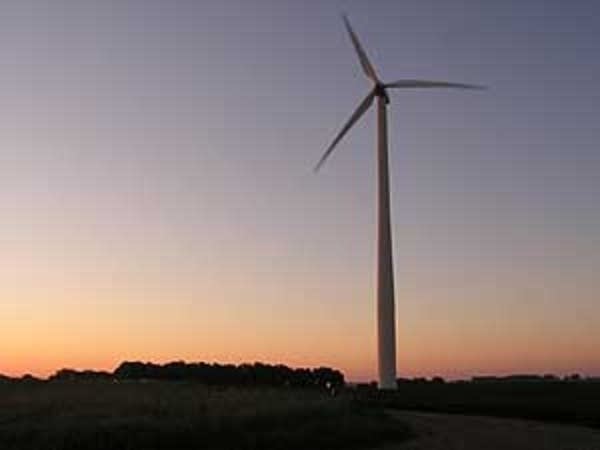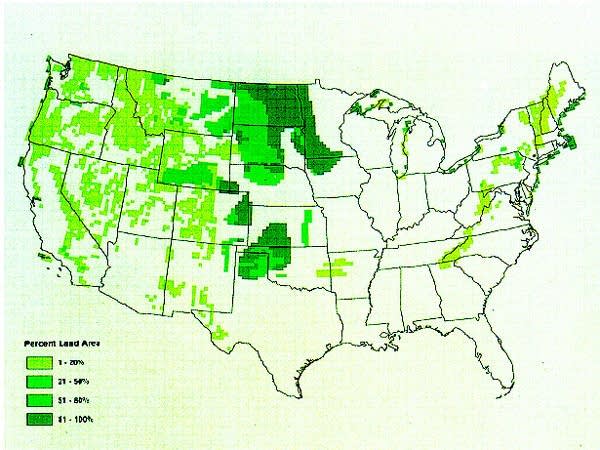Wall Street mess worries wind power developers

Massive wind turbines are an increasingly common sight across the upper Midwest. Developers eager to harness the ubiquitous prairie winds have poured billions of dollars into the region.
But Wall Street woes are slowing the pace of wind development.
"It's a strange time. There's a lot of nervousness," said Jay Haley.

Haley has 25 years of experience in wind development. His Grand Forks engineering company is working on wind projects in about a dozen states.
Create a More Connected Minnesota
MPR News is your trusted resource for the news you need. With your support, MPR News brings accessible, courageous journalism and authentic conversation to everyone - free of paywalls and barriers. Your gift makes a difference.
"At this point, I guess we're just sitting here carefully watching the situation and crossing our fingers," said Haley. "Not quite sure what's going to happen next."
Haley says his company is continuing to work on many wind projects, but has been told to stop work on several wind energy projects on the East Coast.
"In one case it was a project that was fairly well along in the process. But it happened to be a project financed by Lehman Brothers. You know what happened to them," said Haley, referring to the Wall Street investment firm that collapsed in September.
Wind farms are expensive to build and need large amounts of capital investment. Typical financing would be from banks, like Lehman Brothers, and large companies that invest in renewable energy in order to take advantage of federal tax breaks.
"There has been a lot of erosion in the financial markets. However, there's an awful lot of money sitting on the sidelines."
But banks are tightening credit, and the stock market plunge means many of those large companies have seen profits evaporate, which means they are less interested in federal tax breaks.
"Right now things look ugly. And they might get a little uglier before they get better," said New York-based investment advisor Frank Morris.
Morris tracks more than 50 environmental companies for something called the Earth Index. He says the Earth Index has fallen even faster than the Dow Jones.
But Morris thinks investors will return, if the federal government expands mandates for more electricity from renewable sources like wind.
"Everybody wants a sure thing right now, because they got banged up so hard over the past two years or so," said Morris. "But if we have federal mandates and they trickle down to the states, in the short term there is uncertainty, but in the long term we're going to be building this. And what's the long term? Six months from now things will turn around?"

That economic uncertainty has the entire wind industry on edge. But there's still a lot of optimism.
Curt Johnson is CEO of Baxter, Minn.-based Denali Energy, which is working on a North Dakota project that would be the largest wind farm in the country. It'll be months before the first wind turbines are built, but Johnson is confident the financing will be there.
"There has been a lot of erosion in the financial markets, however there's an awful lot of money sitting on the sidelines," said Johnson. "(There's) a ton of money sitting on the sidelines, waiting for this thing to correct itself and come back in. And the smart money is probably going to go after utilities."
Johnson says renewable energy will attract investors because government mandates will make those investments a safe bet.
Minnesota-based National Wind develops wind farms across the country. CEO Leon Steinberg says the financial downturn has not slowed or stopped any of his company's projects.
Steinberg says utilities have a strong incentive to keep developing wind energy, because many states have what's called a Renewable Portfolio Standard. That standard requires a certain percentage of electricity to come from renewable sources. Most utilities have a series of escalating goals for renewable energy over time.
"The renewable portfolio standards trump economic problems," insisted Leon Steinberg. "Utilities have to buy the power or own the power. Because of that demand our projects will get done. Our industry will be fine."
Most analysts agree wind energy will continue to grow. But it's not likely to be the 25 or 30 percent annual growth the industry has enjoyed in recent years.
Xcel Energy is significantly slowing wind energy investment.
Vice President Mark Storeing says the company recently requested and received proposals to build wind energy projects that would produce 650-750 megawatts of power. But Xcel now plans to build only half of those projects.
"What the credit situation and the macroeconomic conditions have forced us to do is reassess that pace of how much, how soon, and how far ahead of the milestones do we want to be as a company. And should we be a bit more patient in pursuit of the renewable portfolio standard, " said Storeing.
Xcel still intends to meet the goals for electricity from renewable sources. But Storeing says uncertain economic times demand a more cautious approach.
Storeing says the wind energy industry faces critical uncertainties in the near term.
Will a recession significantly reduce demand for electricity? Will tight credit and nervous investors make renewable projects too expensive?
No one is sure when those questions will be answered.

